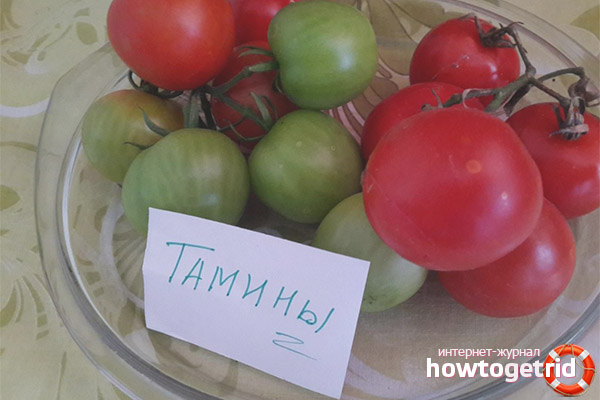The content of the article
Tamina's tomatoes are an achievement of German breeders. The popularity of this species is growing every year, due to the characteristics of the variety.
Characteristic
German tomatoes are distinguished by their versatility, and this variety is no exception. Tamina tomatoes can be grown in different conditions:
- In the open ground.
- In a covered greenhouse.
- Under the film cover.
Breeders identify a number of varietal characteristics that distinguish Tamina from a huge number of other tomatoes:
- The size of the plant. An adult bush grows up to 170 cm in height and is distinguished by an even, slender stem.
- Ripening period. Tamina belongs to early ripening varieties. From the appearance of the first seedlings to the collection of ripened fruits, 2-3 months pass.
- Ripening fruit. Berries ripen simultaneously and in large volumes.
- Productivity The variety has an average yield. From one bush 4 kg of ripened fruits are collected.
- Unpretentiousness. The plant does not require special care.
- Transportation. The ripened fruits tolerate transportation well without losing their appearance.
Description of the fruit:
- The fruits are formed on the brushes of the plant. Each brush grows on itself 7-8 medium-sized tomatoes, the weight of each of which varies from 80 to 100 g.
- Berries are painted in a bright shade of red. They differ in regular, round shape and strong, smooth skin.
- Fruits are not prone to cracking, both during ripening and during heat treatment.
Application
Tamina tomato has good taste characteristics, which allows housewives to use it in the preparation of many dishes. This variety is often consumed fresh, added to salads, squeezed juice, and also used in the preparation of first and second courses. In addition, the fruits of this species are often harvested for the winter, both as a whole and in salads.
Growing Features
Agronomists recommend cultivating a Tamina variety by seed germination. This process should begin 2 months before the planned planting of tomatoes in the ground. Experienced summer residents recommend adhering to the rules of germination of seed material:
- Seed disinfection. Seed material is disinfected with a potassium permanganate solution.
- Sowing. For sowing seeds, a nutritious and loose soil mixture intended for growing tomatoes should be purchased. Seed is placed in containers with soil to a depth of 1-2 cm and covered with a film.
- Airing. The containers should be ventilated daily to prevent the formation of fungus.
- Temperature condition. To achieve one hundred percent germination, maintain the temperature in the room. It should be 23-25 degrees Celsius.
- Watering. Before the first seedlings appear, the soil is irrigated from the spray gun. When the seeds have sprouted, you should switch to moderate watering, carried out as the soil dries.
- Lighting. A plant needs a lot of bright, diffused light. In the event that natural light is not enough, use ultraviolet lamps.
- It is recommended to temper the grown seedlings. For this, containers with plants are taken outside for a week, gradually increasing the duration of their stay in the air.
Young bushes are transplanted using the transshipment method. Planting plants at a permanent place of growth should occur in the evening or on a cloudy day to prevent leaf burns. Arranging bushes on the bed, agronomists advise to adhere to the rule - to place 3 plants on 1 square meter.
Care Features
Experienced summer residents who have been growing Tamina for several years claim that the plant does not need complicated care. However, you must adhere to the standard procedures necessary for the good development of the plant and fruiting:
- Timely watering. Tamina loves water, so dry periods are unacceptable.
- Loosening the soil. Regular loosening of the soil will provide moisture access to the root system and prevent the development of microorganisms dangerous to the plant.
- Top dressing. The entire period of tomato growth is fed with both mineral and organic fertilizers.
- Weed removal. Weeds can cause soil oxidation, which is dangerous for the crop.
- Treatment with biostimulants. Biostimulants provide active plant growth and the formation of ovaries. In addition, they can have a positive effect on the ripening of fruits and increase the amount of yield.
- Stepsoning. The plant needs to be stubbed.
- Garter. An adult bush needs to be tied to a support. Otherwise, the plant may break under the weight of its own fruits.
- Timely collection of fruits. The ripened fruits that remain on the branches of Tamina take a lot of strength and hinder the development of new ovaries.
The gardeners who cultivate the Tamina variety claim that it is impossible to refuse to grow it. Rapid ripening, a minimum of care and a high-quality, rich harvest make us return to planting these tomatoes from year to year.
Video: how often and how much to water tomatoes?











Submit